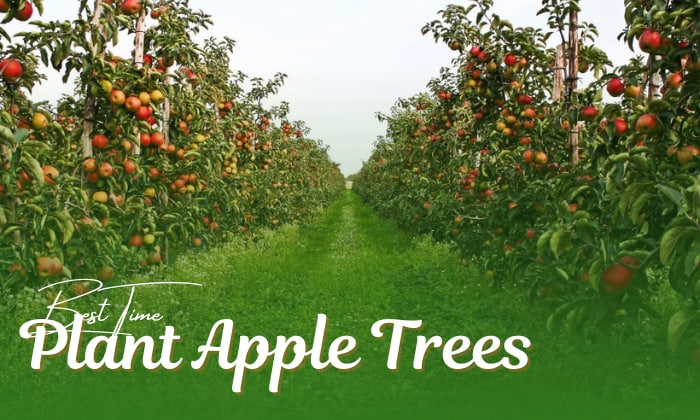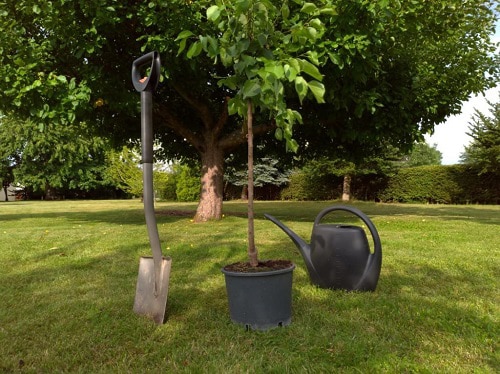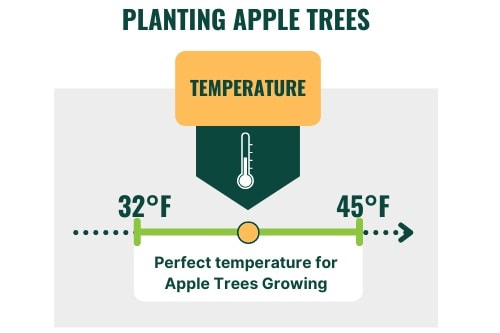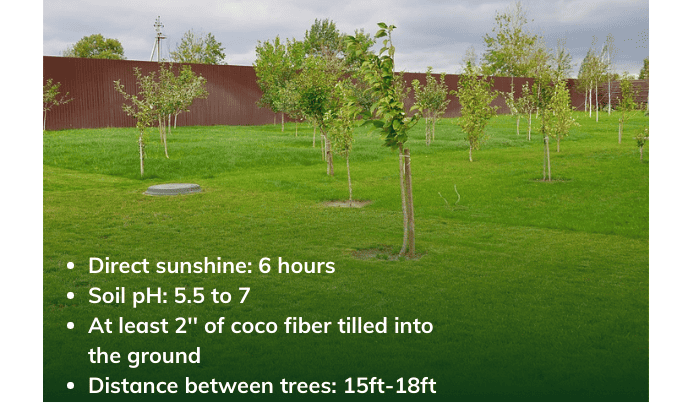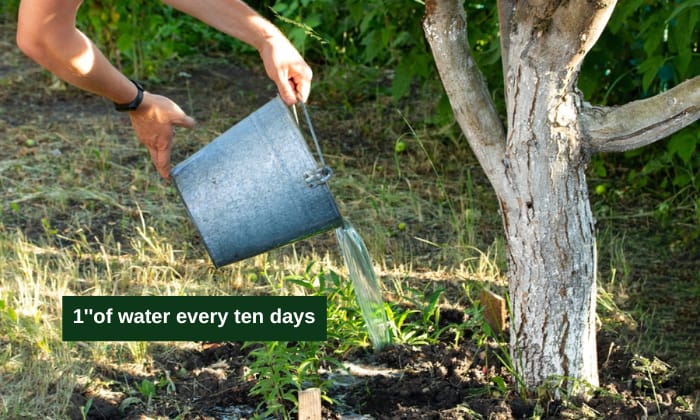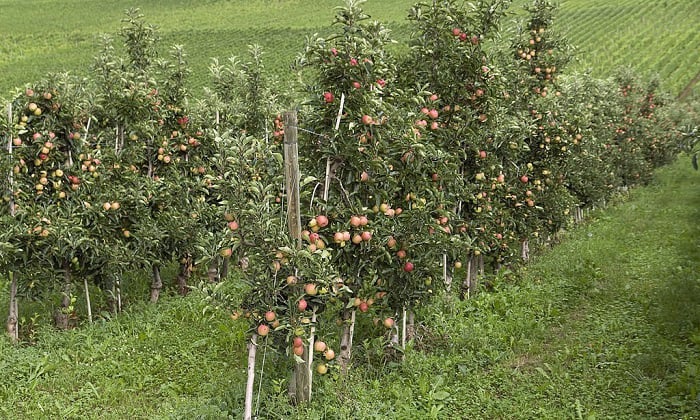Apples are great trees to have in gardens due to their beauty, low maintenance requirements, and high productivity.
If you’re planning to grow them in your backyard but are clueless as to when to plant apple trees, November to March is the ideal growing season, with November and late winter being well-suited for zone 7 and higher only.
On the other hand, residents in lower hardiness zones should wait until spring or February to start gardening.
Table of Contents
Best Time to Plant Apple Trees
1. Plant bare-root trees from November to March
The best time of year to plant apple trees using bare root plants is November to March. Within this period, it is best to pick a day when the soil is workable and not frozen.
Most importantly, do not wait until the last frost has arrived to start gardening. Plant the tree as soon as you receive it, provided all other conditions are met, when the bare-root apple is still dormant.
As for why, dormant trees can establish themselves better when they don’t have to focus their energy on developing foliage, plus the weather in late winter and early spring is mild and less stressful on the plant.
Basic rules aside, below is the apple planting season for different parts of the US. You can rely on the shipping date of the nursery where you placed your order for easier planning, since the general estimate above may be slightly off.
As a rule, warmer southern states can grow apples in late winter, while cooler regions below zone 7 suit spring planting more.
| State | When to plant |
| Minnesota | April and May |
| Washington | March and early April |
| Pennsylvania | March to May |
| Texas | January 1 to February 15 |
| North Carolina | Late December and early January |
| Florida | Late December to February |
2. Plant container trees whenever the soil is not soggy or frozen
Though bare-root trees are a popular option for growing apples, you can also opt for potted plants instead.
These container trees are not picky when it comes to gardening time, and you can put them in the soil anytime you please, provided the ground is not frozen or soggy.
Similar to bare-root apples, container ones are ready for planting the minute they arrive.
3. Planting time and different apple tree varieties
When planting apple trees in fall or winter, it’s critical that you consider their chilling requirements and the climate where you live. Apple trees need a certain number of hours where they’re exposed to temperatures between 32 to 45℉ to produce fruits successfully.
For example, TropicSweet, Anna, and Dorset Golden apples suit North Florida well because they demand only 250 to 300 hours of chilling time to grow.
North Florida has, on average, 500 to 700 chill units per year, making its climate unsuitable for varieties like Red Delicious (which need up to 800 hours of cold weather) and Honeycrisp (which demands up to 1,000 hours of cool temperatures).
You can look up the chilling hours of your locality and different apple varieties before ordering them. In the meantime, we’ve listed some cultivars and their requirements below.
- Beverly Hills – 300 hours
- Granny Smith – 400 hours
- Golden Delicious – 600 to 700 hours
- Newton – 700 hours
- Elstar – 800 to 1000 hours
- Hudson’s Golden Gem – 800 to 1000 hours
Care and Maintenance of Apple Trees
1. Tips for successful apple trees planting
Before ordering bare-root or container plants, note that you may need to grow two trees of different cultivars at once to produce fruits, since most apples don’t pollinate themselves.
There are plenty of guides out there on pollination-compatible varieties, but to give you some suggestions, Golden Delicious will pair well with Granny Smith; Honeycrisp will suit Red Delicious; and Red Rome will complement Ozark Gold.
As for where to plant apple trees, I recommend a spot with six hours of direct sunshine; light, well-drained soil with a pH of 5.5 to 7; and at least two inches of coco fiber tilled into the ground.
If you wonder how far apart should apple trees be planted in rows, the answer is 15 to 18 feet for standard varieties. You can go down to 4 feet if the apple is a dwarf type, but do not exceed 100 feet of spacing to ensure the best results, since cross-pollination may not occur if the trees are too far apart.
Before planting, dig a hole three times wider than the plant roots and two feet deep. Put the apple tree into the hole, cover the roots, then backfill the dug area. To finish, wet the soil with a gallon of water and mulch it with two inches of organic material to discourage weeds.
You should also ensure the graft is four inches above the soil if there is one.
2. Care and maintenance
Take care of an apple tree by staking it at planting time. Insert the stake into the ground about one foot away from the bottom of the plant, and use the rubber strap on the stake to connect it to the tree trunk.
Satisfy apple tree sun requirements as previously mentioned, and give the plant an inch of water every ten days. Use a soaker hose to irrigate the soil once a week and fertilize the tree next spring if there’s less than eight inches of growth after dormancy ends.
You should conduct a soil test to determine the ideal fertilizer, but the general recommendation is one pound of a 10-10-10 for every inch of trunk width measured at twelve inches above-ground.
How Fast Do Apple Trees Grow?
The growth time of apple trees depends on the variety you have.
Dwarf and semi-dwarf trees (which are 6 up to 22 feet tall) take two to five years to bear fruits, while standard varieties often require four to eight years to begin production.
If you plant apple seeds, this timespan may even increase to ten years, which is why people often do not cultivate apple trees this way. Seeds also have the disadvantage of being different from their parents and prone to producing low-quality fruits, so they’re more suitable for adventurous gardeners.
Planting medium aside, though, poor soil, frost damage, and over-pruning may prevent you from having a full grown apple tree.
Conclusion
Apple trees in backyard are a stunning sight, especially when blossoms appear on them during spring and summer. It doesn’t hurt that these plants produce scrumptious fruits for baking and juicing either, so if you’re ready to grow and harvest them in your home, noting down when to plant apple trees is a good first step.
Read more:

Hi, I am William – Floridayards’ digital content creator. My job is to find answers to all your concerns with thorough research and our team’s expert advice. I will also bring you honest reviews on the best products and equipment for raising your beautiful garden. Please look forward to our work!


